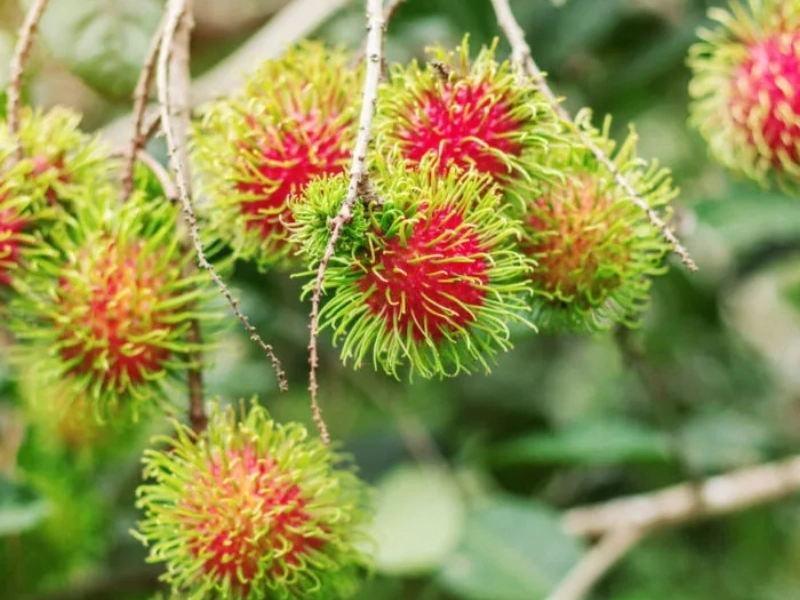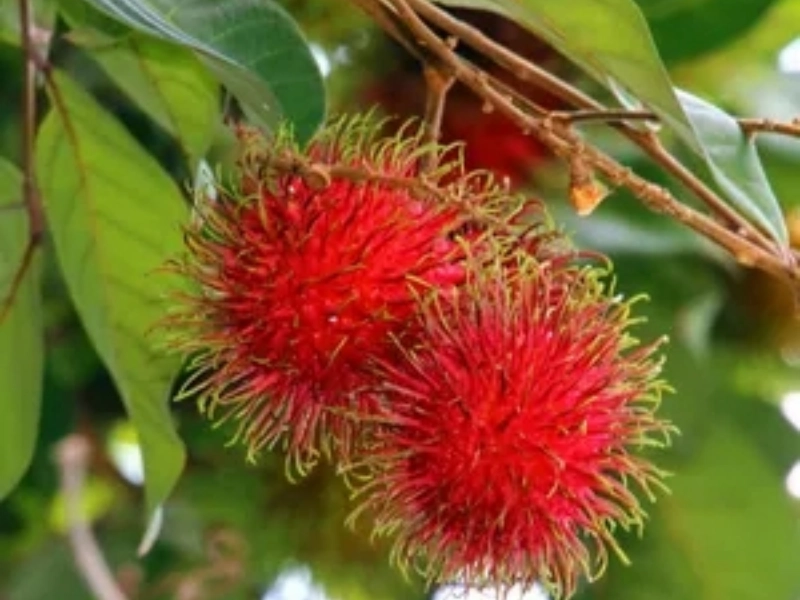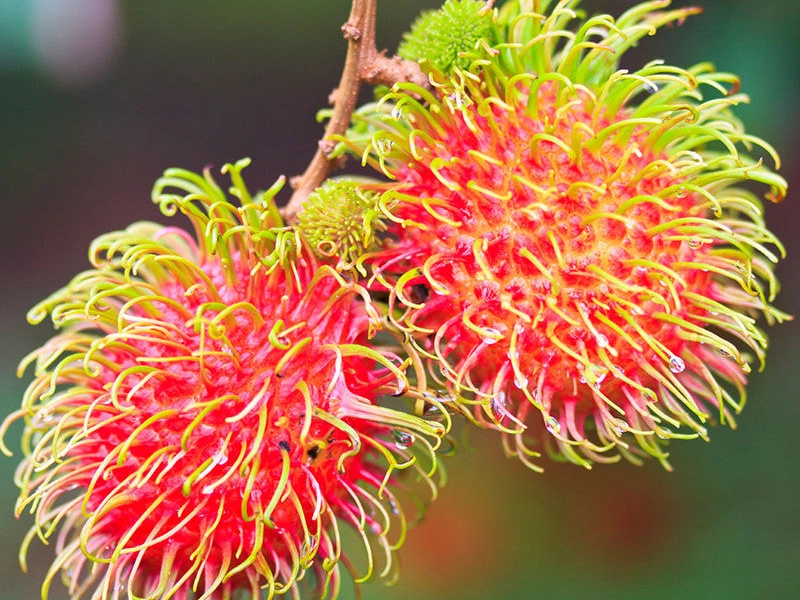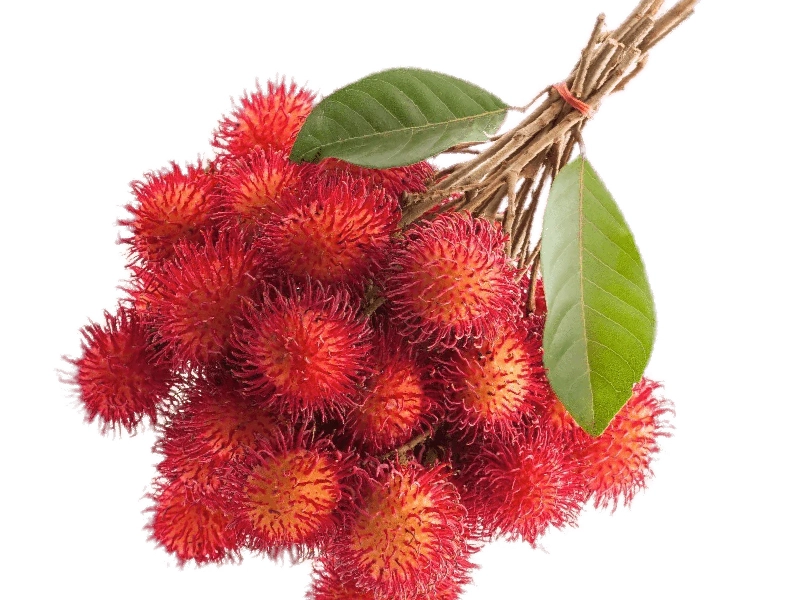Growing Rambutan Trees: A Comprehensive Guide
Tropical fruit trees with distinctive, hairy look and luscious, juicy meat, rambutan trees are known as Originally from Southeast Asia, these trees not only provide mouthwatering fruit but also provide any garden great visual appeal. For both new and seasoned gardeners, growing rambouts may be a fulfilling hobby. This book will address key elements of growing ramboutan trees, including planting, care, pest control, and harvesting, therefore guaranteeing a plentiful supply of this unusual fruit.
Selecting the Correct Area

Raising Rambutan Trees
 Plant your ramboutan tree once you have selected the proper spot. Planting should take place during the rainy season, which gives the young tree enough of moisture. Start by excavating a hole half the width and depth of the tree's root ball. This lets the roots extend readily and settle into the new surroundings.
Check the roots for any evidence of rot or injury before starting to plant. Cut any diseased roots to stimulate fresh development. Centre the tree in the hole such that the root collar runs level with the surrounding ground. Fill the hole with soil, then carefully tamped it down to remove air pockets. After planting, give the tree lots of water to help it settle the ground. Mulching around the base will help to control weeds and maintain moisture, so encouraging good development.
Plant your ramboutan tree once you have selected the proper spot. Planting should take place during the rainy season, which gives the young tree enough of moisture. Start by excavating a hole half the width and depth of the tree's root ball. This lets the roots extend readily and settle into the new surroundings.
Check the roots for any evidence of rot or injury before starting to plant. Cut any diseased roots to stimulate fresh development. Centre the tree in the hole such that the root collar runs level with the surrounding ground. Fill the hole with soil, then carefully tamped it down to remove air pockets. After planting, give the tree lots of water to help it settle the ground. Mulching around the base will help to control weeds and maintain moisture, so encouraging good development.
Taking Care of Rambutan Trees
 The good development of ramboutan trees depends on appropriate maintenance. Especially in dry spells, watering is rather crucial. While mature trees gain from deep watering every two to three weeks, young trees need constant irrigation to build their roots. But be careful not to overwater; rambutan trees may develop root rot.
Encouragement of development and fruit output depends much on fertilisation. For tropical fruit trees, use either a specialist fertiliser or a balanced fertiliser with a 10-10-10 ratio. Under manufacturer recommendations for application rates, apply the fertiliser every three months during the growing season. Pruning also helps to preserve tree shape and promote improved air circulation. To encourage good development, remove any dead or diseased limbs and thin out congested sections.
The good development of ramboutan trees depends on appropriate maintenance. Especially in dry spells, watering is rather crucial. While mature trees gain from deep watering every two to three weeks, young trees need constant irrigation to build their roots. But be careful not to overwater; rambutan trees may develop root rot.
Encouragement of development and fruit output depends much on fertilisation. For tropical fruit trees, use either a specialist fertiliser or a balanced fertiliser with a 10-10-10 ratio. Under manufacturer recommendations for application rates, apply the fertiliser every three months during the growing season. Pruning also helps to preserve tree shape and promote improved air circulation. To encourage good development, remove any dead or diseased limbs and thin out congested sections.
Techniques for Pest Management
 Rambutan trees can be vulnerable to pests and diseases, much as any fruit tree is. Among common pests include fruit flies, scale insects, and aphids. Early identification and control of an infestation depend on routinely looking for symptoms on your trees. Should you find pests, think about using neem oil or organic insecticidal soap to help to regulate their numbers. These safe and efficient remedies for the surroundings.
Preventing diseases is equally crucial. To enable optimal air circulation—which can help lower the risk of fungal infections—make sure trees are spaced correctly apart. Furthermore steer clear of overhead irrigation since damp leaves could encourage the growth of diseases. If you see any symptoms of disease, such yellowing leaves or odd patches, quickly remove the impacted sections to stop the spread.
Rambutan trees can be vulnerable to pests and diseases, much as any fruit tree is. Among common pests include fruit flies, scale insects, and aphids. Early identification and control of an infestation depend on routinely looking for symptoms on your trees. Should you find pests, think about using neem oil or organic insecticidal soap to help to regulate their numbers. These safe and efficient remedies for the surroundings.
Preventing diseases is equally crucial. To enable optimal air circulation—which can help lower the risk of fungal infections—make sure trees are spaced correctly apart. Furthermore steer clear of overhead irrigation since damp leaves could encourage the growth of diseases. If you see any symptoms of disease, such yellowing leaves or odd patches, quickly remove the impacted sections to stop the spread.
Harvesting Rambutan Fruits
One of the most satisfying features of tending these plants is harvesting ramboutan fruits. Usually depending on the kind and growing conditions, rambutan trees start to give fruit three to five years after they are planted. When the fruits feel faintly soft to the touch and turn a brilliant crimson or yellow, they are ready for picking. To gather, gently twist the fruit from the limb to prevent injuring the tree as well as the fruit. Harvesting in the morning when temperatures are cooler will help to retain the freshness of the fruit. Store the rambutan cool, dry once it has been harvested. Fresh, added to fruit salads, or used in desserts, they provide a flexible addition to your cooking arsenal.
Transmission Strategies
Propagation is a good way for you to increase your rambutan tree collection. Although rambutan trees can be developed from seeds, it's crucial to remember that seeds could not yield fruit exactly like their parent tree. Grafting is thereby a more dependable technique. Choose a healthy rambutan tree and make a clip from a mature branch to spread by grafting. There should be multiple leaf nodes on the roughly six-inch snip. Make a clean cut and then attach the cutting using a grafting technique—such as cleft grafting or whip-and-tongue grafting—that guarantees the rootstock is clean. Till it takes root, keep the graft in a humid atmosphere and secure it with rubber band or tape. This approach guarantees that your newly grown trees possess the same desired qualities as their parent tree.
Keeping a thriving rambutan orchard
Maintaining a healthy climate is essential for anyone wishing to establish a more sizable rambutan orchard. Track the general state of every tree to make sure they get enough nutrients, water, and pest control. Using a thorough management strategy can help to maximise fruit output and preserve tree condition. Think about including companion plants that would improve the orchard's habitat. Planting legumes, for example, might increase soil fertility; blooming plants might draw helpful insects for pollination and pest control. Furthermore lowering the risk of pests and diseases is maintaining the orchard clean by clearing dropped fruit and trash. These guidelines will help you to enjoy a thriving rambutan orchard offering mouthwatering fruit for many years to come.








